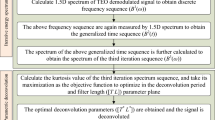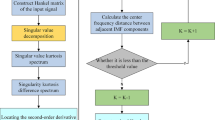Abstract
Blind deconvolution is a widely used technique for fault diagnosis of rolling bearings. Traditional blind deconvolution methods, such as minimum entropy deconvolution, are susceptible to random transients, making it difficult to extract fault features of railway train axle bearings under strong external shock conditions. Deconvolution methods that take the fault characteristic frequency of interest as an input parameter, such as maximum second-order cyclostationarity blind deconvolution, can alleviate this deficiency, however, the bearing fault features are difficult to be extracted when the specified characteristic frequency deviates from the actual value greatly. To overcome these problems, the modified smoothness index of the squared envelope and the modified smoothness index of the squared envelope spectrum are proposed as objective functions of the deconvolution algorithms, allowing two new blind deconvolution methods to be developed for railway axle bearing faults diagnosis. The two proposed blind deconvolution methods are robust to random transients and do not require the characteristic frequency of interest as an input parameter. The fault diagnosis performance of the two proposed methods is verified using the experimental data of actual railway axle bearings and compared with the state-of-the-art deconvolution methods. The results show that the two proposed blind deconvolution methods can adaptively extract repetitive transient features from noisy vibration signals and effectively diagnose different faults of railway axle bearings.
Access this chapter
Tax calculation will be finalised at checkout
Purchases are for personal use only
Similar content being viewed by others
References
Randall, R.B.: Vibration-based condition monitoring: industrial, automotive and aerospace applications. John Wiley & Sons (2021)
Yang, L., Wang, L., Yu, W., Shao, Y.: Investigation of tooth crack opening state on time varying meshing stiffness and dynamic response of spur gear pair. Eng. Fail. Anal. 121, 105181 (2021)
Antoni, J.: Fast computation of the kurtogram for the detection of transient faults. Mech. Syst. Signal Process. 21, 108–124 (2007)
Miao, Y., Zhang, B., Lin, J., Zhao, M., Liu, H.: A review on the application of blind deconvolution in machinery fault diagnosis. Mech. Syst. Signal Process. 163, 108202 (2022)
Lei, Y., Lin, J., He, Z., Zuo, M.J.: A review on empirical mode decomposition in fault diagnosis of rotating machinery. Mech. Syst. Signal Process. 35, 108–126 (2013)
Zhang, W., Shi, P., Li, M., Han, D.: A novel stochastic resonance model based on bistable stochastic pooling network and its application. Chaos, Solitons Fractals. 145, 110800 (2021)
Chen, B., Song, D., Zhang, W., Cheng, Y., Wang, Z.: A performance enhanced time-varying morphological filtering method for bearing fault diagnosis. Meas. J. Int. Meas. Confed. 176, 109163 (2021)
Endo, H., Randall, R.B.: Enhancement of autoregressive model based gear tooth fault detection technique by the use of minimum entropy deconvolution filter. Mech. Syst. Signal Process. 21, 906–919 (2007)
Wiggins, R.A.: Minimum entropy deconvolution. Geoexploration 16, 21–35 (1978)
Cabrelli, C.A.: Minimum entropy deconvolution and simplicity: A noniterative algorithm. Geophysics. 50, 394–413 (1985)
Cheng, Y., Chen, B., Mei, G., Wang, Z., Zhang, W.: A novel blind deconvolution method and its application to fault identification. J. Sound Vib. 460, 114900 (2019)
Peeters, C., Antoni, J., Helsen, J.: Blind filters based on envelope spectrum sparsity indicators for bearing and gear vibration-based condition monitoring. Mech. Syst. Signal Process. 138, 106556 (2020)
Jia, X., Zhao, M., Buzza, M., Di, Y., Lee, J.: A geometrical investigation on the generalized lp/lq norm for blind deconvolution. Signal Process. 134, 63–69 (2017)
Miao, Y., Wang, J., Zhang, B., Li, H.: Practical framework of Gini index in the application of machinery fault feature extraction. Mech. Syst. Signal Process. 165, 108333 (2022)
McDonald, G.L., Zhao, Q., Zuo, M.J.: Maximum correlated Kurtosis deconvolution and application on gear tooth chip fault detection. Mech. Syst. Signal Process. 33, 237–255 (2012)
McDonald, G.L., Zhao, Q.: Multipoint optimal minimum entropy deconvolution and convolution fix: application to vibration fault detection. Mech. Syst. Signal Process. 82, 461–477 (2017)
Miao, Y., Zhao, M., Lin, J., Xu, X.: Sparse maximum harmonics-to-noise-ratio deconvolution for weak fault signature detection in bearings. Meas. Sci. Technol. 27, 105004 (2016)
He, L., Li, Y., Liu, Y., Lin, J.: Minimum correlated generalized Lp/Lq deconvolution for recovering repetitive impacts from a vibration mixture. IEEE Sens. J. 21, 2043–2054 (2021)
Zhou, Q., Zhang, Y., Tang, J., Lin, J., He, L., Yi, C.: Blind deconvolution technique based on improved correlated generalized Lp/Lq norm for extracting repetitive transient feature. IEEE Trans. Instrum. Meas. 70, 3519421 (2021)
Buzzoni, M., Antoni, J., D’Elia, G.: Blind deconvolution based on cyclostationarity maximization and its application to fault identification. J. Sound Vib. 432, 569–601 (2018)
Chen, B., Cheng, Y., Zhang, W., Gu, F.: Investigations on improved Gini indices for bearing fault feature characterization and condition monitoring. Mech. Syst. Signal Process. 176, 109165 (2022)
Nandi, A.K., Mämpel, D., Röscher, B.: Blind deconvolution of ultrasonic signals in nondestructive testing applications. IEEE Trans. Signal Process. 45, 1382–1390 (1997)
Chen, B., Zhang, W., Song, D., Cheng, Y.: Blind deconvolution assisted with periodicity detection techniques and its application to bearing fault feature enhancement. Meas. J. Int. Meas. Confed. 159, 107804 (2020)
Acknowledgements
This work was supported by the National Key Research and Development Pro-gram of China (Grant No. 2021YFB3400704-02), the open project of State Key Laboratory of Traction Power, Southwest Jiaotong University, China (Grant No. TPL2210) and the China Scholarship Council (Grant No. 202107000033). The authors would like to thank Geoff L. McDonald for sharing the code of MED and Marco Buzzoni for sharing the code of CYCBD.
Author information
Authors and Affiliations
Corresponding author
Editor information
Editors and Affiliations
Rights and permissions
Copyright information
© 2023 The Author(s), under exclusive license to Springer Nature Switzerland AG
About this paper
Cite this paper
Chen, B. et al. (2023). Blind Deconvolution Based on Modified Smoothness Index for Railway Axle Bearing Fault Diagnosis. In: Zhang, H., Ji, Y., Liu, T., Sun, X., Ball, A.D. (eds) Proceedings of TEPEN 2022. TEPEN 2022. Mechanisms and Machine Science, vol 129. Springer, Cham. https://doi.org/10.1007/978-3-031-26193-0_38
Download citation
DOI: https://doi.org/10.1007/978-3-031-26193-0_38
Published:
Publisher Name: Springer, Cham
Print ISBN: 978-3-031-26192-3
Online ISBN: 978-3-031-26193-0
eBook Packages: EngineeringEngineering (R0)




